SUNDAY
JUNE 16 - 2013
North
Thorney
Some new flowering
plants for me were Corky-fruited Water-dropwort,
Selfheal and Bee Orchid - just two flower
spikes - in the usual spot at the start of the track
down west Thorney.
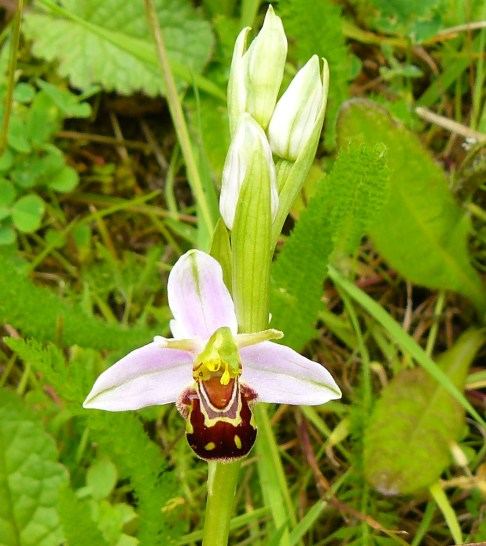
Bumblebee
correction
Yet another
correction. Sorry folks. This time Bryan Pinchen
informed me that the Bumblebee on the Rosy Garlic
flowers at Bosham in yesterday's blog was not a queen
Bombus campestris as I thought, but a male
Bombus pratorum. He writes: "There is a
bold yellow band on the front of the thorax extending
up onto the back of the head, and another at the front
of the abdomen and the reddish orange tail tip, all
quite characteristic of this species. There are also
some yellow hairs on the face that set it apart from
the female/worker. I have corrected yesterday's entry.
Here
is the insect I photographed yesterday
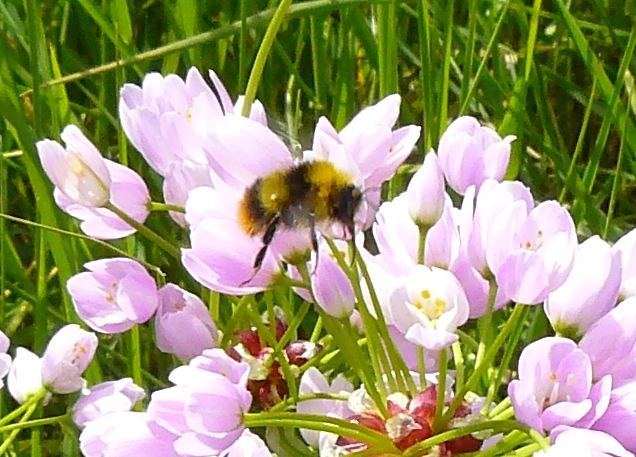
At the moment this is
about the commonest species I'm seeing, it is an early
nester and seems to have managed to get started during
some of the few warm days we had back in April (my
garden Cotoneaster is covered with them daily and a
few B. jonellus, otherwise I seem to be Bumblebee
free). And of course the great thing about the males
is that they don't sting, so can be picked up/handled
without any danger. Had it been B. campestris it would
have been a more overall gingery yellow without any
ginger colouring around the head, it would also look
more sparsely hairy that this., in queen B. campestris
there is no colour band on the abdomen, other than the
orange/brown tip."
SATURDAY
JUNE 15 - 2013
BOSHAM
HARBOUR
Jean and I had a
stroll around Bosham harbour to the east of the town
this morning. We found some interesting plants on the
saltmarshes. They included Red Fescue (looking really
red), Sea Arrowgrass, Sea Plantain, Lesser Sea-spurrey
(with sepals longer than petals), Sea Purslane and
Common Sea-lavender just starting to open. There was a
fine display of Red Valerian along the main path from
the town, including a lot of the less common
white-flowered variety.
On the eastern side,
we came across a good flowering of Rosy Garlic
with a Bumblebee feeding on the flowers. Rosy
Garlic used to be rare in our area, but Ralph Hollins
says it has been spreading locally in recent years.
The Bumblebee was identified by Bryan Pinchen as a
male Bombus pratorum.

Scurvygrass
query
Also, on the roadside
embankment on eastern side of the harbour we saw some
white-flowered plants which I thought at first were
English Scurvygrass. I brought a sample home and on
closer inspection they appeared to fit the description
of Common Scurvygrass (Cochlearia officinalis
agg) in my guides. In particular, the upper leaves
were clasping the stem and the pods were rounded. In
English Scurvygrass the leaves narrow gradually into
the stalk and the pods are flattened. However, Common
Scurvygrass is not found in SE England according to
the local floras, so that rules that out! So, that
must make it either Danish Scurvygrass or English
Scurvygrass??
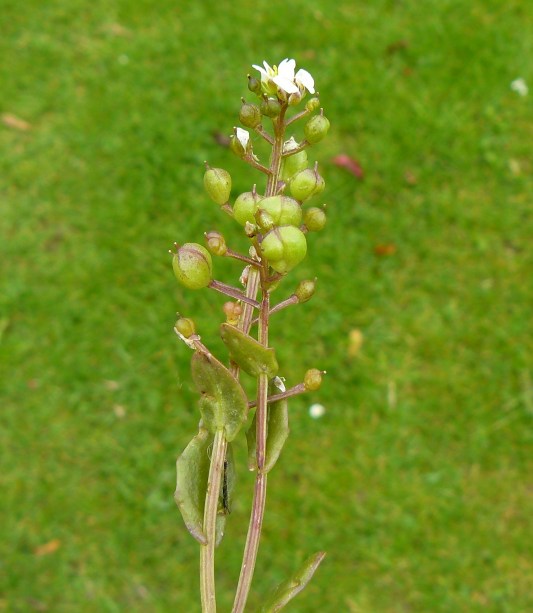
OTHER
NEWS
Moth
Caterpillar Correction - Lackey Moth
Both Ralph Hollins and
Jane Brook wrote to correct my identification of the
silken tent of caterpillars that I found on east
Thorney yesterday. They were not Brown-tail Moth
caterpillars, but those of the Lackey Moth.
Ralph sums up the main differences: a) Brown-tail Moth
caterpillars are more hairy than my photo, b) they
have a line of white dots down each side near the top
and c) they have two reddish dots in the middle of the
back near the tail end. The 'tents' (communal
colonies) of both types of caterpillar look similar.
The Lackey Moth does not release hairs that can cause
skin irritation or present a hazard to health.
Brown-tail
Moth on the left (Ralph Hollins's photo) and the
Lackey Moth on the right (my photo)
Green
beetle correction - female 'thigh beetle'
Ralph Hollins also
corrected my tentative guess at the green beetle on a
buttercup yesterday. It was not Musk Beetle, but the
female of our familiar 'thigh beetle' (Oedemera
nobilis) which does not have the swollen thighs of the
male.
The
male 'thigh beetle' is on the left and the female
without the swollen thighs is on the right
CAROLINE'S
GARDEN NEWS
Caroline French
provides an update on the wildlife news in her North
Emsworth garden:
Birds
"My impression is
that, in our garden at least, this has so far been a
more successful breeding season than last year, albeit
rather late to get going. House Sparrows at the front
and back of the house are on their second broods and
there seem to be plenty of young Starlings around. I
built a Starling nest box a few weeks ago but
unfortunately didn't get it put up in time for this
nesting season. One of the challenges is to safely get
the box fixed to the wall at a height just below the
guttering, and thereafter to take it down and clean it
out every year. My window-cleaner kindly put up my
sparrow terrace three years ago but he has since
retired. Perhaps there is a gap in the market for
birdbox services?
I finally saw my first
juvenile Goldfinch on 11th June (we were away 3-10th
June, so they may have been around a bit earlier),
compared to 19th May 2011 and 23rd April 2012. There
has been a pair of Chaffinches using the garden this
spring for the first time, so they must have nested
somewhere locally. Since 12th June there has been what
appears to be a juvenile in the garden, judging by its
rather scruffy appearance, what look to be short
wings, and naive behaviour. It has been feeding
independently.
I was going to pull up
my Forget-Me-Nots which had 'gone over' until I
spotted several Goldfinches feeding on the seeds. It's
nice to see the birds foraging for 'natural' food in
the garden rather than relying solely on the feeders.
I was really thrilled to come home yesterday and find
a male Bullfinch on the feeders - the first I've ever
seen during the six years at this house! Perhaps it's
the same one you had in your garden. It was soon
joined by a juvenile Goldfinch and a juvenile
Greenfinch."
Hedgehog
I have a Hedgehog
using one of the wooden houses in the garden. This is
the third Hedgehog to use this box in the past 12
months, one of them having hibernated in it over
winter. The hibernating Hedgehog moved out in early
May so I emptied out the box, cleaned it, and put some
fresh straw inside. Within a week a new Hedgehog had
moved in! I'm attaching a photo of the box with the
lid off, showing the two internal compartments which
prevent predators from entering.
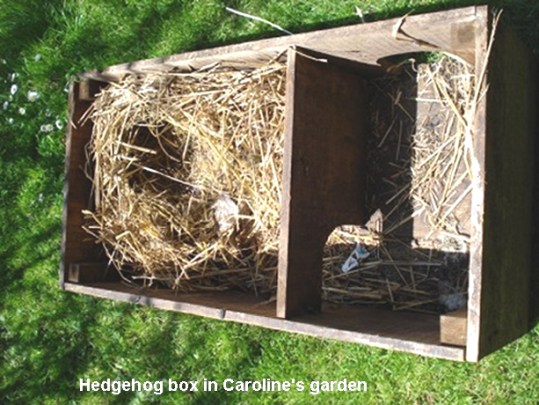
Last time I was at
Brent Lodge Wildlife Hospital they were selling these
for, I think, around £25.00. The fact that the
box is so readily occupied suggests to me that there
may well be a shortage of suitable sites for them to
rest up or nest. I place my box in a shady position
under a Verbena bush, where it is protected from the
worst extremes of rain, wind and sun. The food that I
put out each evening may be an added local attraction,
but I also leave some of my grass long and shove dead
leaves to the back of the flower beds so the Hedgehogs
can forage for natural foods.
BAFFINS
POND
Eric Eddles sent the
following photo of the family of Barnacle Geese with 4
goslings on Baffins Pond. I recall Barnacle goslings
during the 1990s when I used to survey the pond
regularly, but have not heard of any in recent years.
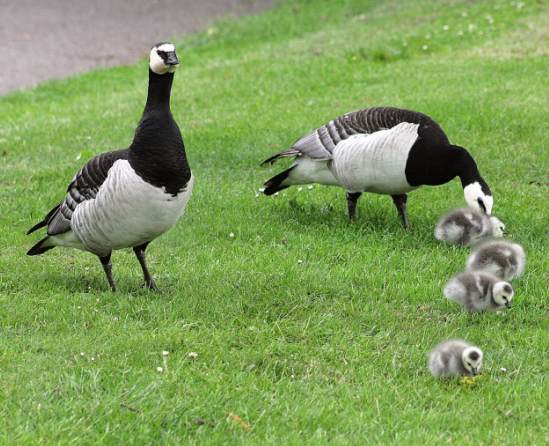
FRIDAY
JUNE 14 - 2013
MILLPOND
NEWS
Emsworth
Millpond
It was excellent to
see the Mute Swan pair with their one cygnet on the
millpond this morning, all feeding happily together.
Thankfully, the pen has finally given up brooding the
three addled eggs in the 'litter nest', though that
has not stopped the ever-present audience looking down
at the nest from the bridge.
Peter
Pond
The Mute Swan family
with eight cygnets was on the pond this morning, all
looking very healthy and feeding well. Let's hope the
parents can hang on to them, but 8 young birds can be
very vulnerable with predators on the next pond with
hungry chicks to feed.
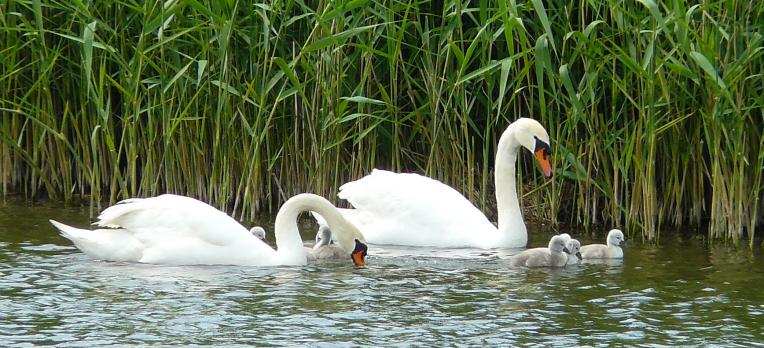
Two Swallows
were feeding over the pond while I was watching the
swans.
Slipper
Millpond
The Great Black-backed
Gulls were on the pond and I could just make out the
three chicks on the centre raft. Brian Lawrence was
also 'buzzed' by the male yesterday and got this photo
of the bird in action overhead.

BROOK
MEADOW
Bumblebees
A ginger bee with a
white tail and dark abdomen feeding on Beaked
Hawk's-beard flowers was probably Bombus
hypnorum. This Bumblebee was first recorded in
Hampshire in 2001and occasionally in southern English
counties. Bombus hypnorum was also recorded on Brook
Meadow by Bryan Pinchen in July 2010.
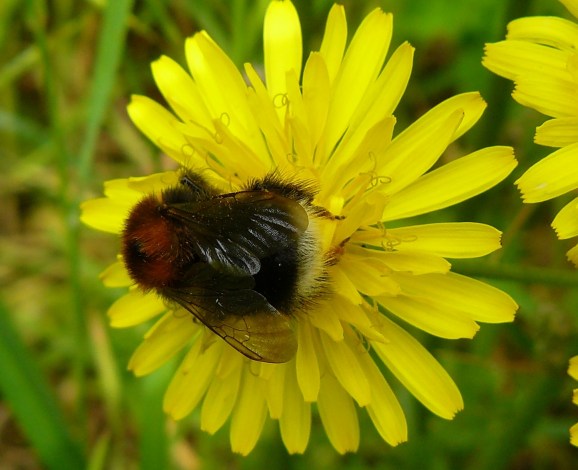
Another small bright
ginger Bumblebee with a yellow abdomen that I found
feeding on Yellow Rattle flowers on the orchid area is
probably Bombus muscorum which,
according to Bryan Pinchen, is a declining species,
being largely restricted to coastal areas.
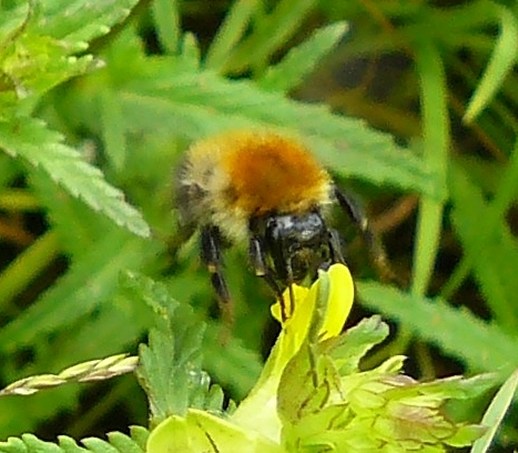
Other
insects
I was pleased to see
my first Banded Demoiselles of the year on Brook
Meadow. Both male and female insects were in flight
near the Lumley Stream. Here is the male with the
characteristic band across its wings.
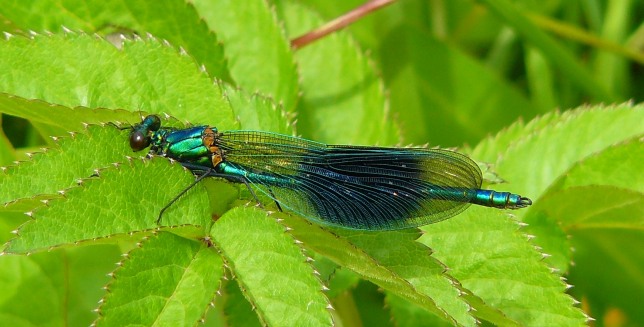
Here is the female
with plain green wings
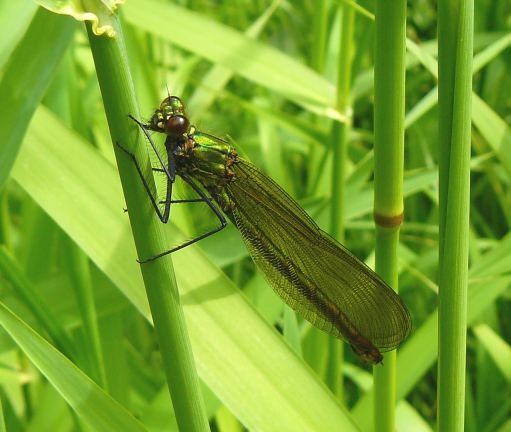
I found a green beetle resting on a buttercup flower
which I have not been able to identify. My very very
tentative guess from Chinery's book is Musk Beetle
(p.278)

I was on Brook Meadow
for about an hour this morning without seeing a single
butterfly. The wind was still chilly, but it was
reasonably warm and one might have expected to see
some.
Plants
There is certainly
nothing wrong with the large Ash tree on the
railway embankment which overhangs the north path of
Brook Meadow. It is covered with large bunches of very
healthy looking keys.
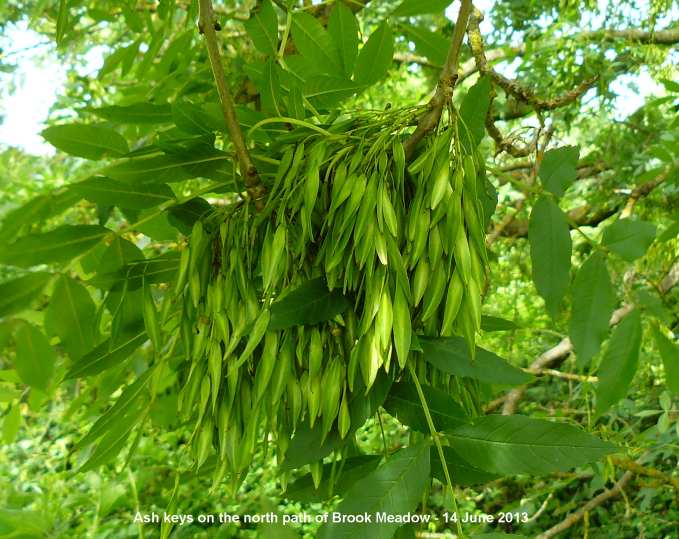
The 8 Southern
Marsh Orchids are growing well on the east side of
the orchid area, but there are no others in the
immediate area that I could find. The first spikes are
now showing on Reed Canary-grass.
Great
Burnet (Sanguisorba officinalis)
I was unsure about
this bright red seed head which I thought at first
might be a buttercup. How wrong I was. It turned out
to be the rare Great Burnet - see blog entry for June
17 for full details.
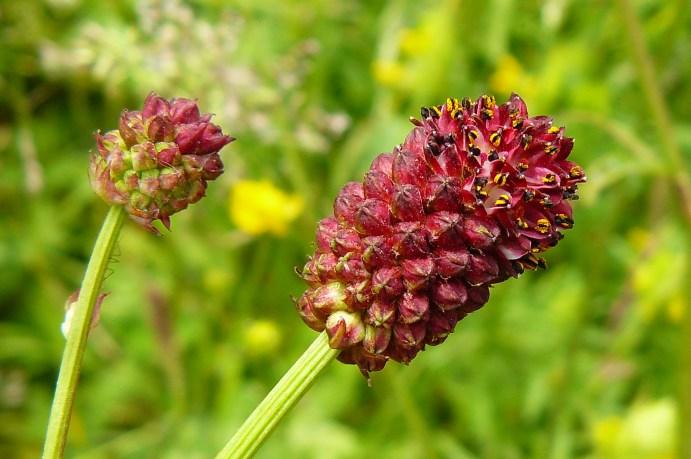
THORNHAM
POINT
Jean and I walked from
Prinsted to Thornham Point. We had a look for the
Osprey that has been seen near the new nesting
platforms, but there was no sign of it. I found the
following newly flowering plants; Lesser Stitchwort,
Hop Trefoil and Field Bindweed. We found a nest of
Brown-tail Moth caterpillars on a rose bush
near the point.
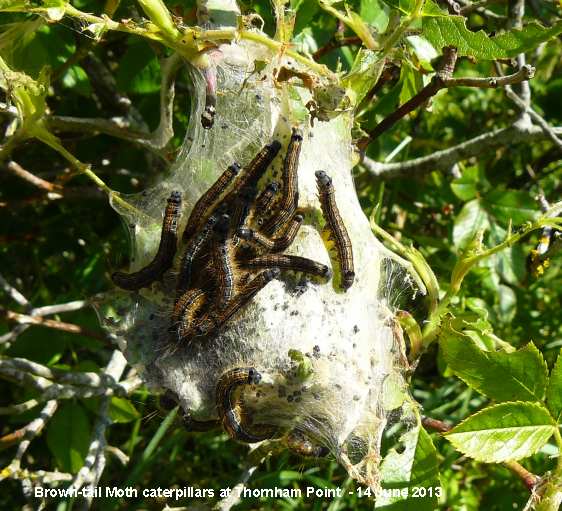
THURSDAY
JUNE 13 - 2013
MILLPOND
NEWS
Emsworth
Millpond
At about 11.30am the
pen Mute Swan and her cygnet from the "litter nest"
were both feeding together quite happily on the water.
Some kind person had scattered some grass cuttings
into the pond which should provide some sustenance.
The cob was near the nest which still has the 3 addled
eggs in it.
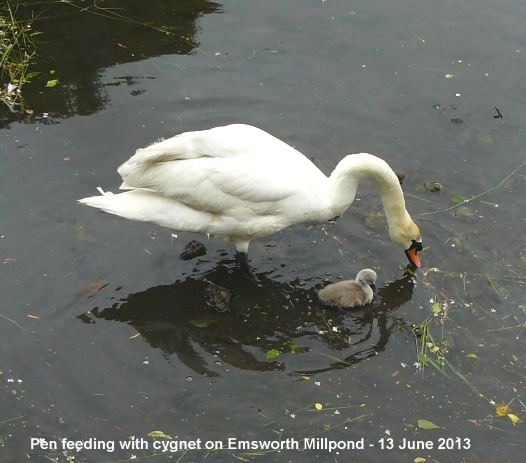
Peter
Pond
When I arrived at
Peter Pond at about 12 noon, I was somewhat shocked to
find the pen swan on the island standing beside a
completely empty nest. However, after a few minutes
the 8 cygnets gradually emerged from the surrounding
reeds and the pen took them onto the pond where they
swam about.
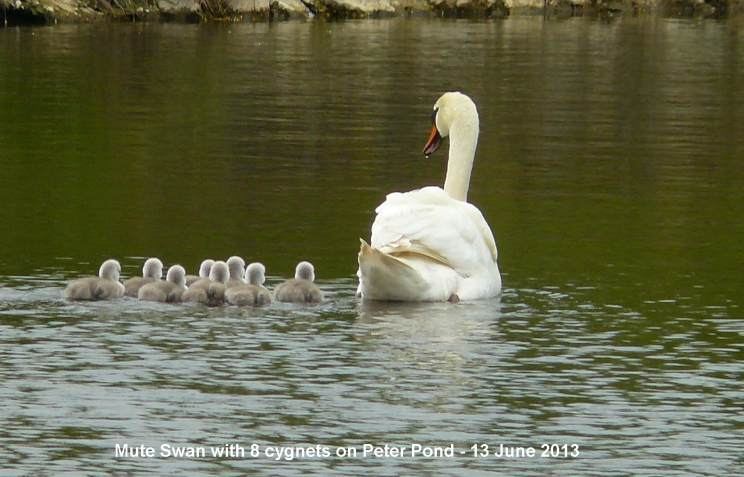
The cygnets spent some
time on their mother's back and hiding beneath her
wings - with one acting as 'look-out'.
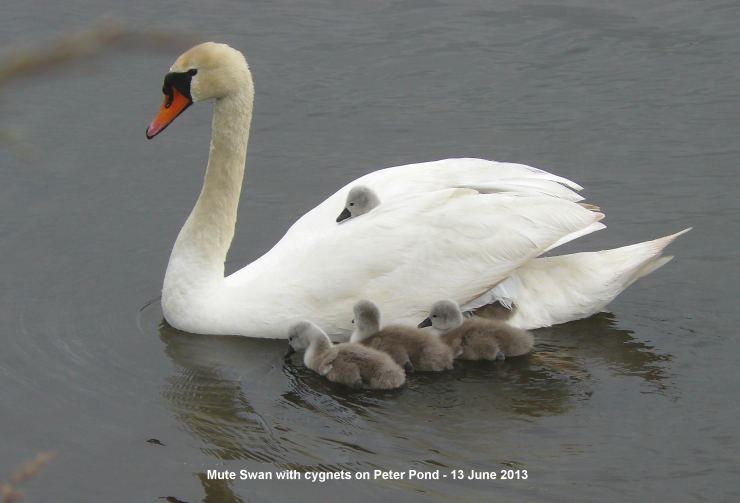
Slipper
Millpond
I could clearly see
two of the three Great Black-backed Gull chicks on the
centre raft with their two parents, but the third one
may have been hiding. While I was watching the chicks
through my binoculars, I was followed around and
constantly 'buzzed' by the male parent Does everyone
get this treatment, or just me? Coots were in the nest
boxes on both rafts.
Fishbourne
Millpond
Roy Hay reports to say
there is only one cygnet on Fishbourne Millpond this
year. Here is Roy's photo.
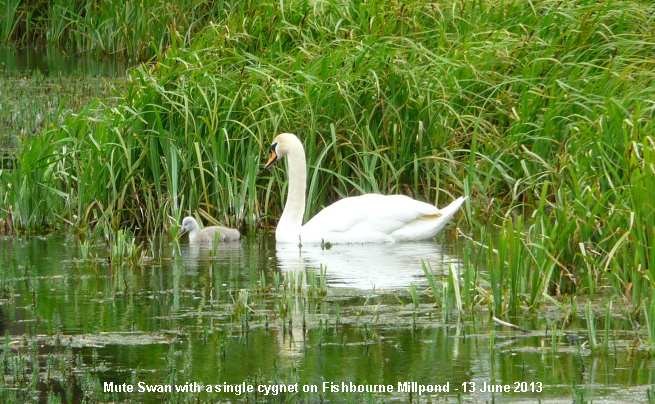
WAYSIDES
NEWS
I had a wander around
some of the local waysides this morning, looking for
newly flowering plants. Common Ragwort was out on the
New Brighton Road Junction. While on the Railway
Wayside I found Hedge Woundwort and Creeping Thistle
in flower plus the first spike of Timothy. Dog
Rose was also in flower near the new fence. Two worker
Bumblebees (Bombus lapidarius) with red
tails and black thorax were feeding on the Black
Medick flowers on the Railway Wayside.
For the full report
and photos go to . . . http://www.emsworthwaysides.hampshire.org.uk/few-NEWS-current.htm
OTHER
NEWS
Bullfinch
in garden
We have had a couple
of visits today from a male Bullfinch on one of the
sunflower heart seed holders. This was our second
visit from this rare garden bird this spring.
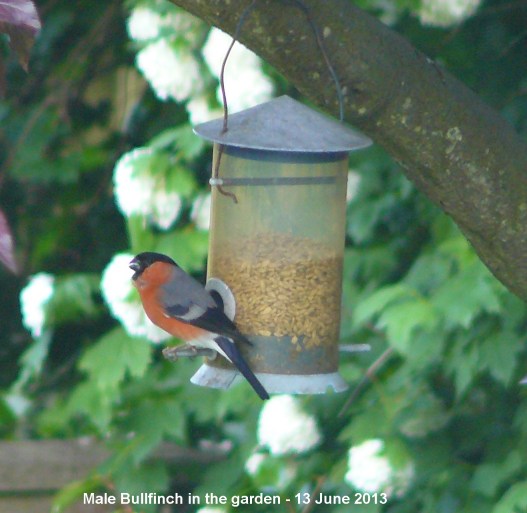
WEDNESDAY
JUNE 12 - 2013
CYGNETS
GALORE
Quite amazing news,
but we have no less than 12 Mute Swan cygnets in
Emsworth in three families. This is the best total for
the town I can recall and much, much, better than last
year when we had a total of zero!
Peter
Pond - 8 cygnets
The big break through
came with the hatching of 8 cygnets on the Peter Pond
island today. Maurice Lillie e-mailed me this morning
to say he had seen at least 6, possibly 7, at about
7.40am. I was even luckier when I went down there at
about 4.30pm when the pen was standing up on the nest
and all eight cygnets could be easily counted. All the
cygnets were normally coloured with no 'Polish' white
ones, which I was half expecting as the mother was a
'Polish' swan (having pink legs and feet).
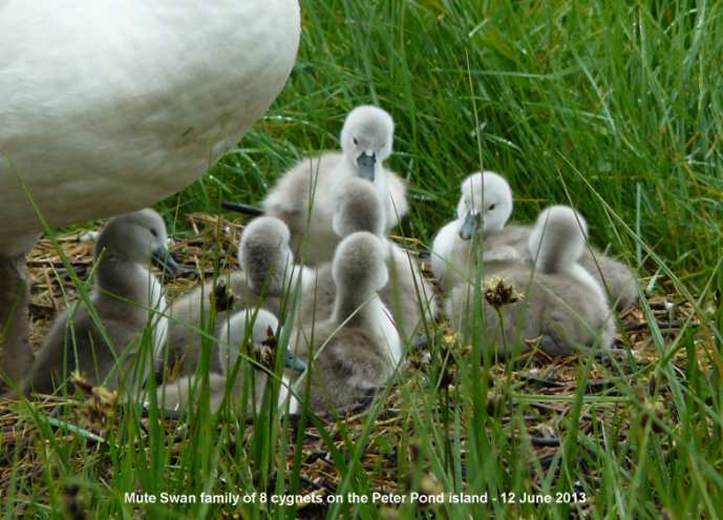
There were 8 eggs, so
all have been hatched. Now, the work begins, to care
for them and get them feeding. I get the feeling that
the cob may not be all that much help. Today he was
lounging as usual on the east bank of the pond, but I
may be judging him too harshly. As for predators, the
youngsters would appear to be fairly safe from the
Great Black-backed Gulls which do not seem to go onto
Peter Pond, where the Coot family with 5 chicks have
remained unmolested. But, Mr Fox will be threat so
long as the cygnets are on the island.
Dolphin
Lake - 3 cygnets
The Mute Swan family
with 3 cygnets were at the top end of Dolphin Lake
this afternoon. All the cygnets were feeding and
looked healthy. One of the cygnets is of the 'Polish'
variety (ie all white) though the pen is not 'Polish'
(ie has normal dark legs). This is the family from the
nest on the marina embankment which started off with 8
cygnets.

Emsworth
Millpond - 1 cygnet
Finally, the Mute Swan
was still brooding her three addled eggs on the
'litter nest' on the town millpond with the cygnet
swimming around in the rubbish on the water nearby.
The brooding instinct clearly remains very strong,
though surely she must give up soon?

TUESDAY
JUNE 11 - 2013
MILLPOND
NEWS
Emsworth
Millpond
The 'litter nest' on
the town millpond is now surrounded by water, so it
looks as if the Environment Agency has opened the
sluice to let the water in again. I had a couple of
looks today, but both times that stubborn swan was on
the nest brooding its three remaining eggs, which have
not a hope of hatching after all this time.
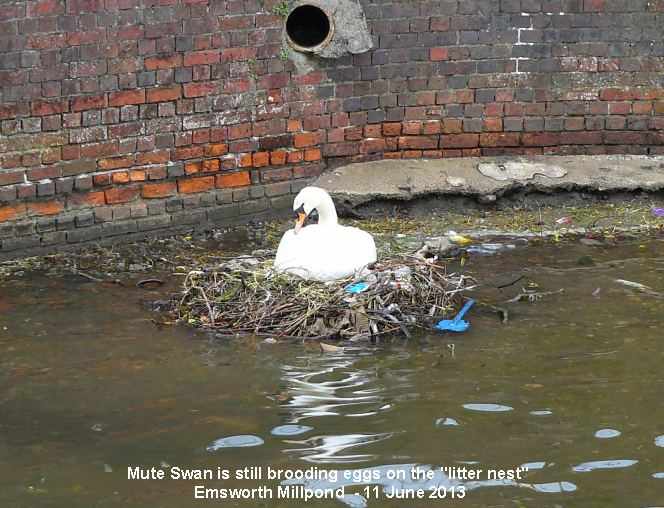
Sadly, the raised
water level in the millpond has put paid to the brave
Coot nest despite its great height.
Peter
Pond
At long last, the Mute
Swan on the Peter Pond island has produced some
cygnets. There were just two little ones when I
checked at 2.30pm, but Juliet Walker found four or
five were out when she was there 3 hours later. As
there were 8 eggs in the nest, there could be more to
come. Here is Juliet's photo.

The Coot family with 5
chicks was on the water and all looking healthy.
Slipper
Millpond
The Coot nest on the
north raft is still active with what looked like the
chick from the first brood sitting on the eggs while
the two adults foraged on the water. It is fairly
common that Coot chicks help in looking after
subsequent broods, but I have never seen one actually
sitting on a nest before.
WAYSIDES
NEWS
Sulphur
Cinquefoil
A single plant of
Sulphur Cinquefoil was in flower on the Bridge Road
Wayside. I have recorded this plant each year in
exactly this spot since I first discovered it on July
14, 2011. It is very hairy with whorls of sharply
toothed leaflets up the stem. The buttercup-type
flower has slightly notched petals like Creeping
Cinquefoil, but is much larger. The plant is south of
the Goat Willow tree on the southern verge.
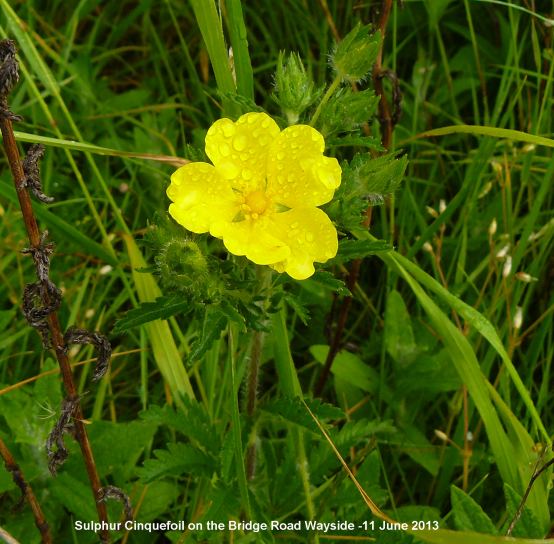
From The New Atlas: "A
perennial herb, originating from gardens or as a
contaminant of grass seed and naturalised on waste
ground, roadside banks and grassy places; rarely
occurring as a casual. Lowland. Neophyte (change
+0.99). P. recta was introduced into Britain by 1648,
and was known from the wild by 1858 (Middlesex). It
seems to have become more frequent since the 1962
Atlas, but this may be an artefact of better
recording. A European Boreo-temperate species,
naturalised in Scandinavia north of its native range,
and in N. America." It is described as 'rare' in The
Hants Flora.
MONDAY
JUNE 10 - 2013
MUTE
SWAN NEWS
'Litter
nest'
My scouts tell me that
the Mute Swan cygnet from the 'litter nest' on
Emsworth Millpond has been in the water today and
feeding well and looking good. This is very good news.
When I checked about 7.30 this evening the pen was
back on the nest presumably with the cygnet under her
wing. Clearly, the instinct to brood eggs remains
strong. However, it looks as if the Environment Agency
has allowed the water level to rise in the pond as the
water was lapping around the base of the nest.
Marina
family
The Mute Swan family
with three cygnets that nested on the marina
embankment was in the harbour near the quay. One
cygnet is a pale 'Polish' variety, but both parents
are normal.
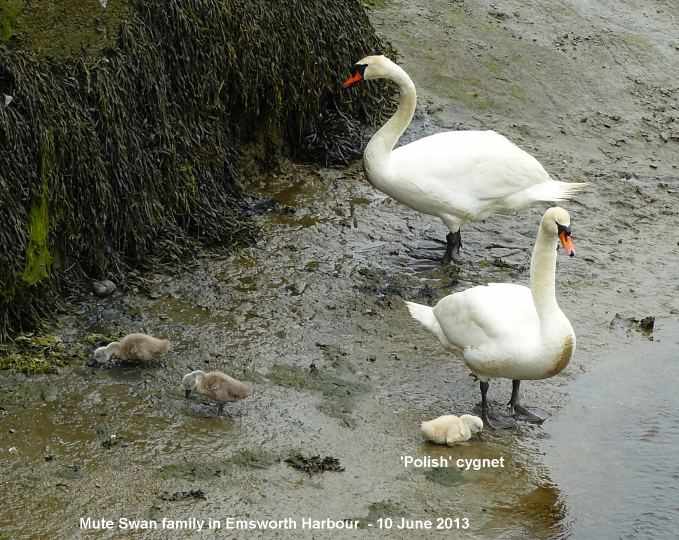
Peter
Pond nest
The Mute Swan was
still sitting on the Peter Pond island when I checked
a couple of times today with no sign of any hatching.
WAYSIDES
NEWS - Christopher Way cutting
A brief report along
with a few pictures of the clerance of the Christopher
Way verge wayside are on the waysides blog at . .
.
http://www.emsworthwaysides.hampshire.org.uk/few-NEWS-current.htm
SATURDAY
JUNE 8 - 2013
MILLPOND
NEWS
'Litter
nest'
At about 10am this
morning, I was very pleased to see the cygnet on the
water with its mother being introduced to the art of
feeding! There is a line of weeds which I had not
noticed before growing on a raised area of the
millpond, which the adult swan stirred up, producing
fragments of food stuff (insects) which the cygnet
appeared to be picking off the surface of the water.

I watched mother and
child slowly swim onto the main millpond where the
Coots were nesting. This produced a little skirmish
with the Coots, but the swan was unpeturbed and moved
on serenely.
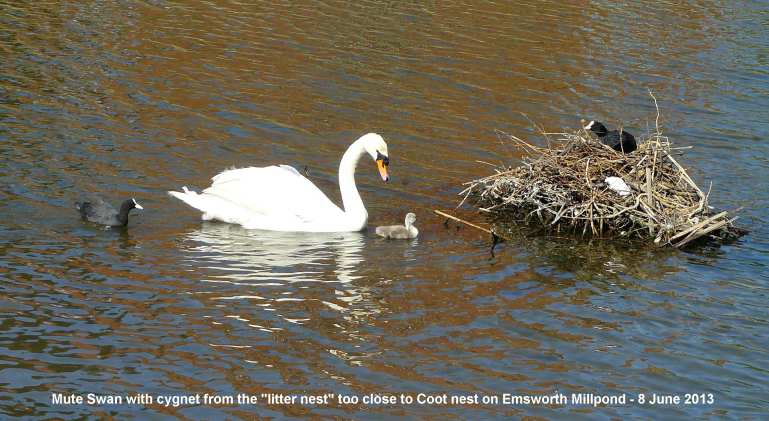
I had another look
this afternoon and the pen was back on the 'litter
nest', with the cygnet beneath her, in front of an
admiring crowd. Clearly, the instinct to brood the
eggs is still strong, but this is bound to weaken as
nothing happens.
Peter
Pond
I checked Peter Pond
where the pen was still sitting on the nest on the
island with no sign of any cygnets. Clearly, the egg
laying must have continued long after when I thought
it had finished. This is not surprising as 8 eggs have
been seen in the nest. The cob was on the water
nearby.
Plant
news
Goat's-beard is
in flower on the Peter Pond embankments and just one
flower on the Seagull Lane patch on Brook Meadow,
which was struggling to get through the rampant
grasses. I counted 12 Ragged Robin plants in
flower on the Lumley area and the area below the
causeway. They are slowly increasing, but it looks
like another poor year.
There are now 8 flower
spikes of Southern Marsh Orchids on the east
side of the main orchid area which I have marked with
twigs. Two to go to equal last year's number. Orchid
expert Nigel Johnson says the Southern Marsh Orchids
in his garden are yery small this year and he is only
finding them as they flower when the flower spike
projects upward by an inch or two. At this rate the
orchid count on South Moor is going to be tricky!
A
couple of Southern Marsh Orchids growing together on
Brook Meadow
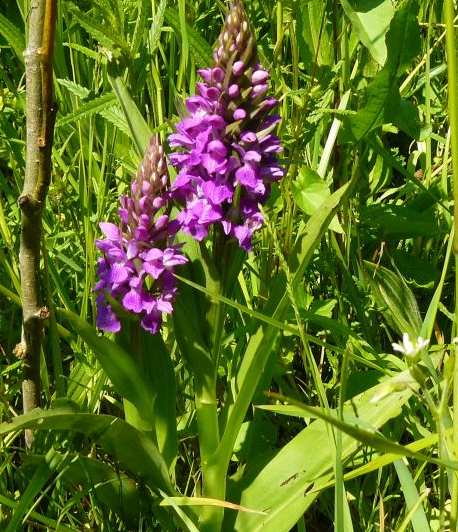
Wild
Clary (Salvia verbenaca)
John Norton wrote to
say he checked out the Gosport colony of Wild Clary
today (opposite Trinity Green near the town centre).
"There were 40 plants, including several in flower -
last year we had 33. These are not next to any busy
roads and partly sheltered by adjacent houses and an
Ash tree. It sounds as though your colony may well
have succumbed to the cold winter. The only other
thing to consider is if the colony was next to a road
where a lot of salt was put down over the winter,
which may have not have helped."
FRIDAY
JUNE 7 - 2013
MILLPOND
NEWS
"Litter
nest"
The Mute Swan on the
'litter nest' on the town millpond continues to
attract the crowds (as shown in this photo), though
generally they have not had a great deal to watch with
the pen settled firmly on the nest still brooding the
3 remaining eggs. These eggs will not hatch now, so
one hopes that the mother quickly abandons them and
takes her cygnet onto the water, where there is
nutritious insect food for the youngster.
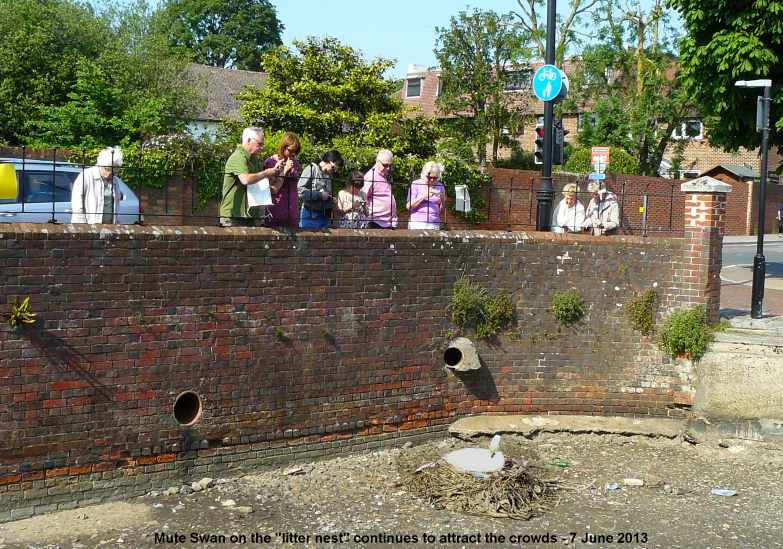
On one of her visits
today, Juliet Walker got this shot of the cygnet
swimming in the shallow water of the millpond with its
mother nearby which is good to see.
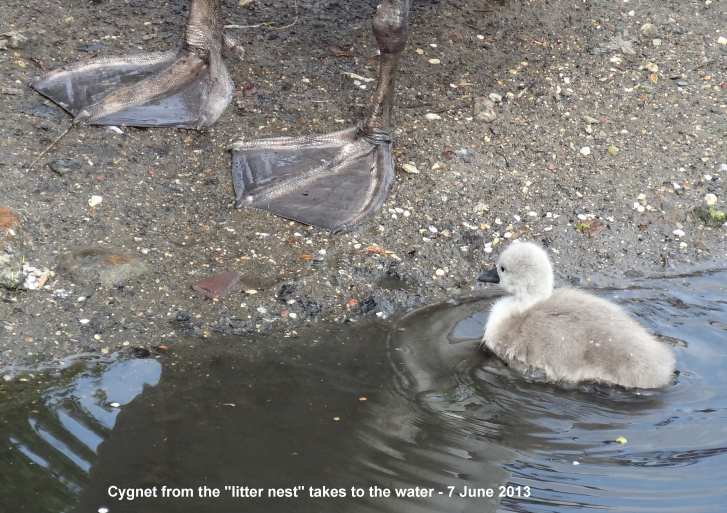
This is not the first
'litter nest' on the town millpond to produce cygnets,
but the first, to my knowledge, in this spot near the
bridge. The others have all been in the in the south
west corner of the millpond near the Emsworth Sailing
Club. The last one to produce any young was in June
2007 when two cygnets were hatched, one of which
survived thanks to its mother taking it up the
Westbrook Stream, where it could feed on natural
vegetation. I am not sure if this strategy would work
this time as the grill at the end of St James Road has
been changed to prevent debris getting into the
culvert from the stream. This will certainly prevent
access into the stream area by the adult swan, though
a small cygnet might be able to squeeze through.
Peter
Pond
Meanwhile, the Peter
Pond 'Polish' swan continues to brood her eggs, well
past my predicted date of hatching.
Great
Black-backed Gulls
The Great Black-backed
Gulls were both on the centre raft on Slipper Millpond
with their 3 chicks, one of which was on the water.
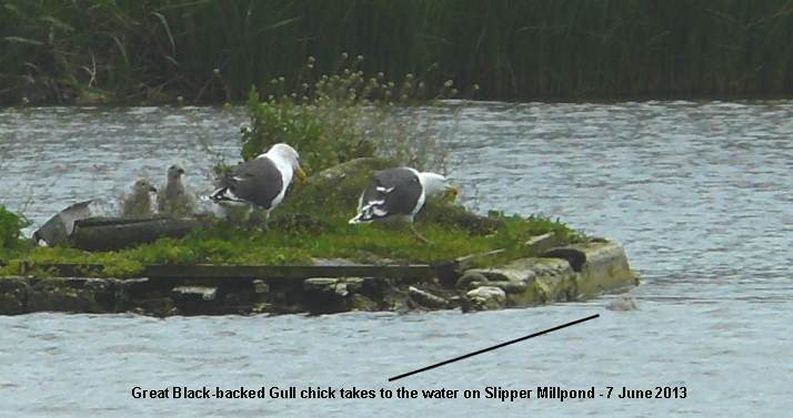
WAYSIDES
NEWS
For more news about
the disappearing plants on the waysides and the views
of two eminent botanists on the situtation. Go to the
waysides blog at . . . http://www.emsworthwaysides.hampshire.org.uk/few-NEWS-current.htm
THURSDAY
JUNE 6 - 2013
MILLPOND
NEWS
'Litter
nest' drama
Well, what drama we
have had on Emsworth Millpond today. I have checked
the situation several times and every time the bridge
at the top of the millpond was packed with people
anxiously watching the slowly unfolding events below.
To cut a long story short, this morning, one of the
two cygnets got out of the nest and seemed to get
stuck in the twigs at the edge of the nest. There was
much discussion about whether it should be rescued and
put back in the nest, but sensibly nothing was done. I
thought it looked pretty weak anyway and one would not
be doing mum any favours by handing back a weakling
chick. Anyway, the cygnet proceeded to die in the
blazing sun on the mud in front of an increasingly
emotional crowd. Nature was happening in front of
their eyes. Meanwhile, the pen swan, quite
unconcerned, sat tight on the nest with the remaining
cygnet and the 3 eggs beneath her.
At around 7pm Juliet
Walker witnessed mum and cygnet get off the nest and
walk to the small stream which was several yards away
for their first swim an event that she captured in the
photo below. Thanks Juliet. That was a good bit of
news, for the swan needs to feed the cygnet on insects
which she will only find in the water. By the time I
got down there at 8pm the pen was back on the nest
with the remaining cygnet snug beneath her along with
the three eggs. The eggs will not hatch now, so let's
hope the pen and her cygnet will get back onto the
water quickly to find food.

Peter
Pond nest
No such drama on the
Peter Pond nest where the pen has been sitting tight
all day with no sign of any hatching. When I checked
this evening the pen stood up to turn the eggs and I
could see there were definitely no cygnets.
OTHER
NEWS
Banded
Demoiselle
Brian Lawrence saw the
first Banded Demoiselle of the year on Brook Meadow
and got this photo of a male. They are late emerging,
but are usually the most common damselfly on the
meadow.
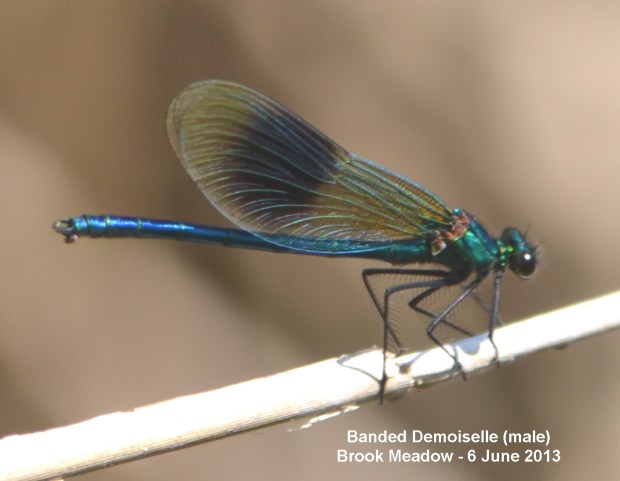
Fox
families
Susan Kelly still sees
the young foxes sometimes in her Emsworth garden. She
thinks there are two litters, of 2 and 3 cubs
respectively, with two separate earths. She says, "The
pair seem younger than the triplets and although I
have seen them all together, they are more often
visible in separate groups. One early morning I
watched a mother and two cubs basking and bonding on
the lawn, which was lovely."
Red
Lily Beetle
Peter Milinets-Raby
photographed what he thought at first was a
Black-headed version of a Cardinal Beetle which I got
on Brook Meadow on June 1, but it turned out to be the
very similar Red Lily Beetle (Lilioceris lilii) which
attacks lilies and fritillaries and is a bane of
serious gardeners.
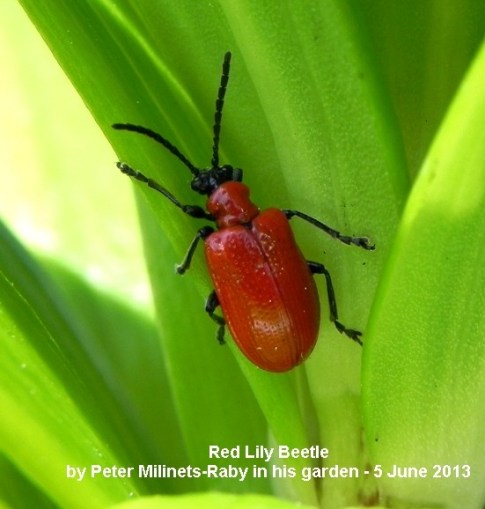
Here
is the Red-headed Cardinal Beetle for
comparison

Late
Orchids
On May 31, I found no
Southern Marsh Orchids at all on the South Moor,
Langstone where normally thousands are in flower at
this time of the year. Ralph Hollins also went to
South Moor yesterday and found just one flower spike
open. His theory is that their late emergence may be
due to a 'double whammy'. Not only will the orchids
have been delayed by the cold and rain of the spring,
but also those weather conditions may have been
advantageous to other species growing in the same
habitat. Thus the increased growth of Rushes, Meadow
Sweet and other vegetation will have delayed the
orchids by limiting the amount of light and heat
getting through to the ground layer where the orchid
tubers are developing. Ralph also noticed that the
dead vegetation from an autumn cut had formed solid
blankets of cover which could not be to the advantage
of the orchids.
WEDNESDAY
JUNE 5 - 2013
WAYSIDES
NEWS
Disappearance
of Wild Clary
I visited the
Christopher Way verge wayside this morning and there
was still no sign of Wild Clary. I am astonished at
how all 40 or so plants, which have regularly flowered
for the past three years, could have disappeared. More
about the disappearance of Wild Clary and Martin
Rand's explanation along with other waysides news can
be seen on today's waysides blog at . . .
http://www.emsworthwaysides.hampshire.org.uk/few-NEWS-current.htm
Common
Blues mating
I came across a pair
of Common Blue butterflies locked together in mating
for several minutes on the embankment below the new
access ramp on the Railway Wayside. The male, in
particular, had very ragged wings as if it had been
out for some time, though this was the first Common
Blue I had seen this year anywhere. They overwinter as
a caterpillar and turn into a chrysalis before
emerging as an adult butterfly in May. Maybe, they
were delayed this year by the cold spring, like most
other things?
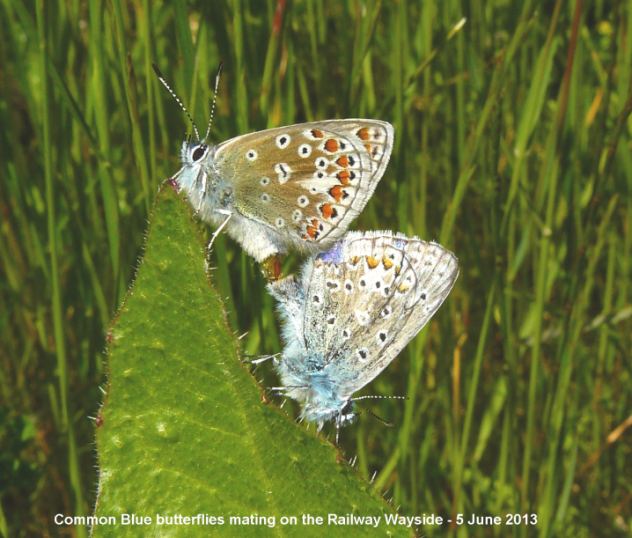
MILLPOND
NEWS
'Litter
nest' hatches!
The Mute Swan on the
'litter nest' started hatching her cygnets today, one
day before my predicted hatching date. When I was
there at 1pm there was just one cygnet in the nest
along with 3 eggs. When Juliet Walker was there at 6pm
there were two cygnets and 2 eggs as shown in her
photo below. The other eggs may still hatch, but they
may not be fertile, we shall have to wait until
tomorrow to see. Juliet e-mailed later to say there
were 3 unhatched eggs.
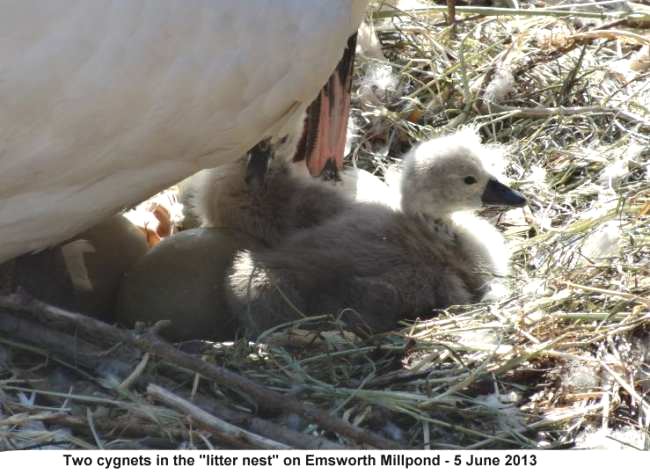
I had another look at
8.30pm this evening, but the swan was sitting tight on
the nest, watched by an admiring audience. I am amazed
by the interest people have shown in this nest as I
rarely go past the site without seeing someone staring
down.

One big problem the
parents will have is feeding the cygnets, since there
is a distinct lack of natural vegetation on the
millpond. However, in their first few weeks the
cygnets will need high protein animal matter,
especially water insects, of which there should be
some on the millpond with the Westbrook Stream running
into it from the north. Foot paddling by the parents
also helps to dislodge food items from the mud. By
about 2 weeks of age the cygnets should move onto
natural vegetation.
Peter
Pond nest waits
The Mute Swan on the
Peter Pond island is still sitting with no visible
signs of cygnets though it must be very near the time.
She is 2 days over my predicted time of hatching,
though with 8 eggs, I could not be sure of the date of
the final egg.
OTHER
NEWS
Water
Vole
Malcolm Phillips was
back on the meadow and photographed a Water Vole on
the north bank of the river at 2.15pm. This was our
first sighting for a couple of weeks, in fact, since
Malcolm was away.

Whitethroat
with food
Here is a fine image
of one of the three breeding Whitethroats at Hayling
Oysterbeds taken by Michael Johnstone with a beak full
of insects for its hungry nestlings.
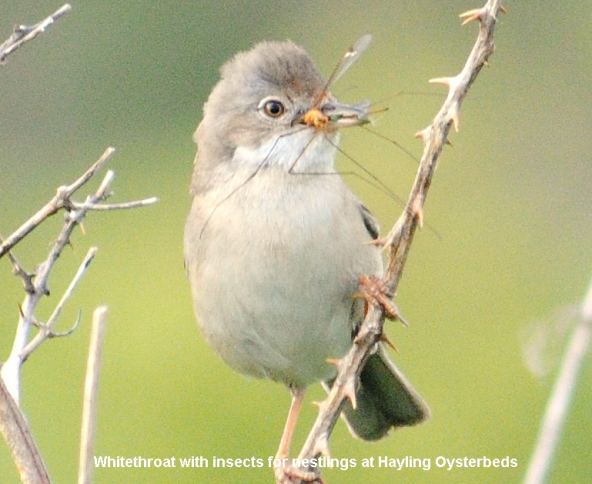
Gull
chicks galore
Brian Lawrence went
over to Hayling Oysterbeds yesterday to see the
hundreds of Black-headed Gulls that have nested on the
'tern islands' in the lagoon. As shown in his photo
there are lots of tiny brown spotted gull chicks.
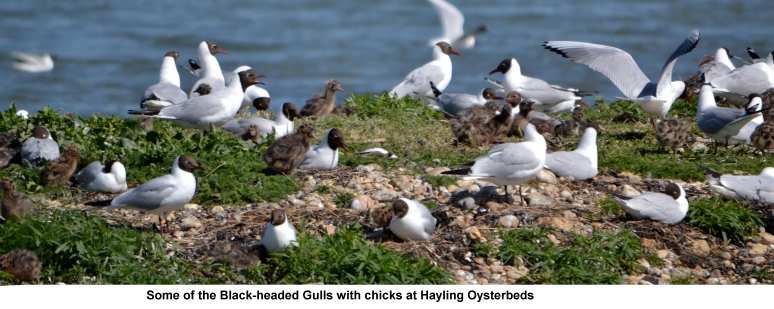
TUESDAY
JUNE 4 - 2013
MILLPOND
NEWS
Brendan Gibb-Gray
e-mailed to say last night he saw the Mute Swan
from the marina, who had the eight cygnets, but
she now only has three. I confirmed this today. Where
the other five have gone is anyone's guess, but the
prime suspects are the Great Black-backed Gulls on
Slipper Millpond which have three hungry chicks to
feed. It is also possible the cygnets were taken by
the Carrion Crows which are serious opportunists.
There is no further
news concerning the Mute Swan nests on the town
millpond and on Peter Pond. But, hatching is
imminent. Penny Aylett told me today that she and
others had been concerned about the cob of the Peter
Pond pair which had been sitting on the eastern
embankment without moving. It may be unwell or maybe
it is just a nervous father waiting for the delivery!
A Reed Warbler
was singing from the reedbeds in the south eastern
corner of the millpond. The reeds are badly denuded in
this area and the bird seems unlikely to remain.
I discovered
Russian Comfrey on the east side of Slipper
Millpond during a plant survey this evening with Gavin
Miller. This makes me more sure that I have not seen
any on Brook Meadow this year. Slipper Millpond also
has Common Comfrey and White Comfrey.
Meanwhile, over on the
town millpond the regal Coot remains on its ever
rising tower of a nest. What an astonishing
construction.
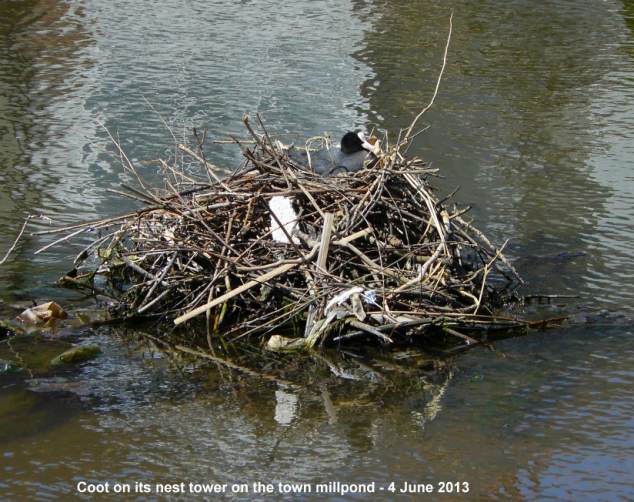
OTHER
NEWS
More
Orchids on Brook Meadow
I discovered another
four Southern Marsh Orchid flower spikes all in the
same area as the first one in the east side of the
main orchid area on Brook Meadow. I have marked all
flowers with twigs.
Woodpecker
predation
Penny Aylett also told
me about the predation of her Blue Tit and Great Tit
nests by a Great Spotted Woodpecker. She showed me the
Blue Tit nest box, the hole of which had been hammered
and widened by the Woodpecker to enable it to reach
the chicks, all of which were taken. The same type of
predation was shown on 'Springwatch' tonight. Just as
well it was not a Magpie. That would have caused a
fuss!
Where
are the insects?
Peter Milinets-Raby
was dismayed at how few insects there were in his
garden. Where are the Hoverflies? The Bees? The
Ladybirds? He wonders if everyone else experiencing
this lack of insect life. As for butterflies, one or
two Whites passing through and that's it! However, he
did manage to get this unusual photo of a Green Shield
Bug using its proboscis to collect a drop of liquid
from its under belly.
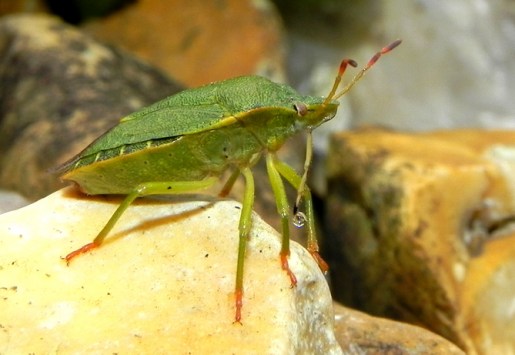
Spotted
Flycatcher correction
Thanks to Tony Davis
and Peter Milinets-Raby for their replies about
Charlie Annalls' Spotted Flycatchers reported in
yesterday's blog entry. They both agree (and I do)
they were Meadow Pipits and the fact that they have
insects in their beaks means that they were feeding
young
Damselfly
catches fly
Colin Vanner got this
excellent photo of what I assume to be a Large Red
Damselfly catching a fly.

MONDAY
JUNE 3 - 2013
EMSWORTH
Waysides
News
Jane Brook and I went
around some of the local waysides this morning. Among
the plants we found were Yellow Rattle and Plicate
Sweet-grass at the Bridge Road, Cat's-ear on two
waysides and Smaller Cat's-tail grass on the
Lillywhite's path verge. We saw 6 Swifts flying
over Bridge Road, the most so far this year. We also
had a nice female Orange Tip on the Seagull
Lane patch on Brook Meadow.
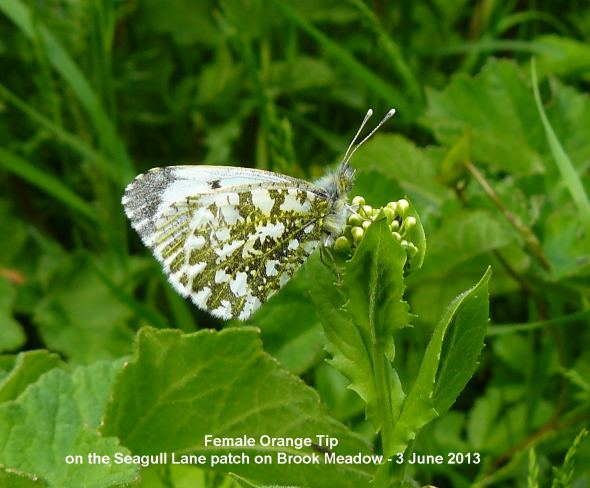
For the full report go
to . . . http://www.emsworthwaysides.hampshire.org.uk/few-NEWS-current.htm
Millpond News
The Mute Swan is still
on her 'litter nest' on the town millpond near the
bridge. A Coot has taken advantage of the low and
steady water level in the millpond (from the
Environment Agency for the Mute Swan nest) to
construct its own nest which is now more of a tower.
One wonders how the bird climbs into it! Meanwhile, on
Peter Pond, the Mute Swan is still sitting on her nest
on the island with no sign of any cygnets as yet.
Today was my predicted hatching date, though I was not
certain when the last egg was laid, so there might be
longer to wait.
Brendan's
Mallard
Brendan Gibb-Gray told
me the sad news that about two weeks ago the Mallard
nesting in his garden with 13 eggs left in the morning
and failed to return. At the time, Brendan says, there
were 4 males stalking the area, but otherwise no clues
as to her fate.
OTHER
NEWS
Langstone
Mute Swans
Jon Cox took some
pictures of the cygnets and ducklings at Langstone
Mill Pond near The Royal Oak (May 27). He said it
looked like Mum was taking them on a circuit of the
Mill, but they all had to leap from the footpath to
the mud first.
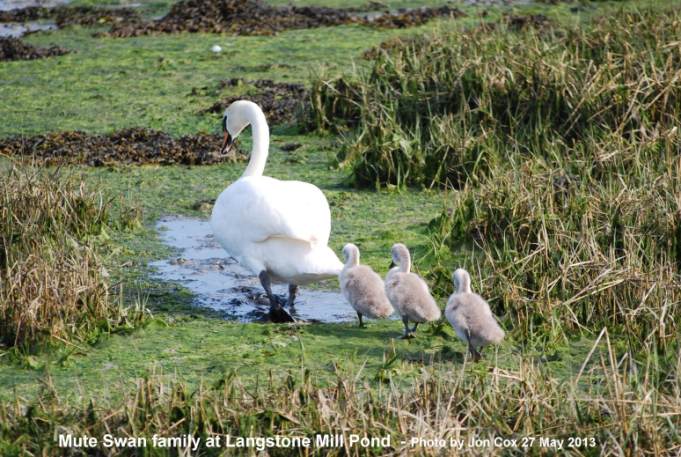
Langstone
Little Egret nests
With regard to the
report by Peter Milinets-Raby on the blog entry for
June 1, Ralph Hollins says . . "if you stand with your
back to the wall of the Mill House you can easily see
10 Little Egret nests with adults and as you walk
round the pond you can increase that to something like
20 (I believe the actual total is around 30).
Broad-bodied
Chaser
Colin Vanner got a
nice shot of what looks like an immature male
Broad-bodied Chaser, this weekend in a field near
Southwick.
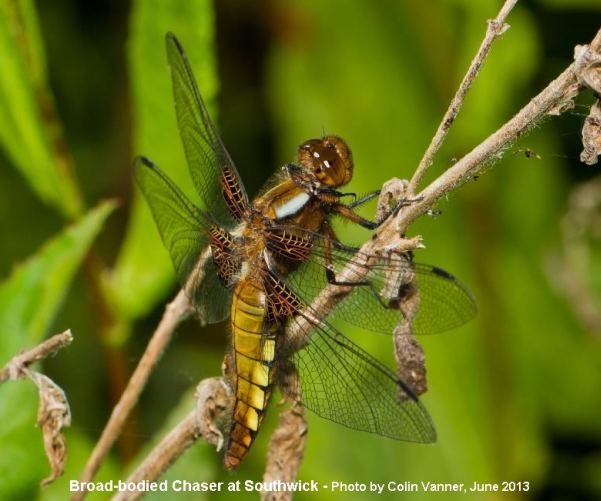
Roe
Deer at Fishbourne
Roy Hay got this photo
of a buck Roe Deer lying in the grass in Fishbourne
Meadows this morning. There was also a doe with it but
not in shot.

Damselflies
mating
Peter Milinets-Raby
got this super image of a pair of Large Red
Damselflies mating on his garden pond this morning.
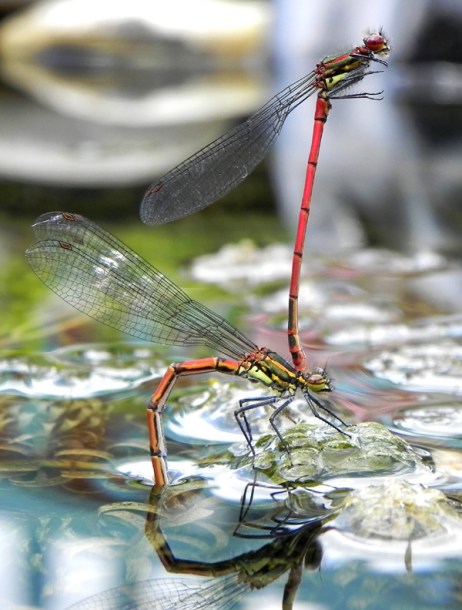
Angle
Shades Moth
Peter also sent me
this photo of a moth which he nor I had any idea
about, so I sent it to Tony Davis, my moth man who
said it was an Angle Shades. Tony says, it is a
resident species but also occurs as a migrant. He had
a number of Diamond-back Moths over the weekend so
there is some migration occurring at the moment.
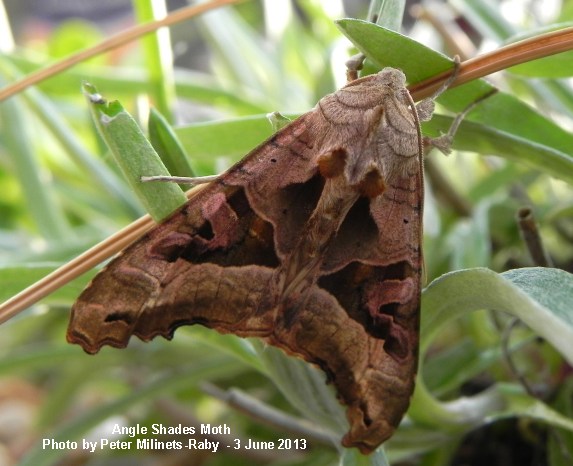
I would never have
recognised it from the picture in Chinery's Guide. He
says it is abundant everywhere and can be found at all
times of the year, but I don't recall ever having seen
one (or heard of it before!).
Spotted Flycatchers -
CORRECTION
MEADOW PIPITS
Charlie Annalls has
just returned from a visit to East Anglia and was
happily surprised to see the mention of a glut of
Spotted Flycatchers along the Dorset coastline on
yesterday's blog entry (June 2). She says, "Whilst
away I saw my first Spotted Flycatcher at the sand
dunes at Felixstowe, two lovely birds with their
mouths absolutely crammed with flies! I'd not seen
this before but suspected some type of "flycatcher".
They perched on very slender reeds from where they
flew many deft missions to catch the innumerable flies
and bugs flying around the dunes. A very impressive
sight which I watched for some 20-30
minutes".
Thanks to Tony Davis
and Peter Milinets-Raby for their replies about
Charlie Annalls' Spotted Flycatchers. They both agree
they are Meadow Pipits and the fact that they have
insects in their beaks means that they were feeding
young.
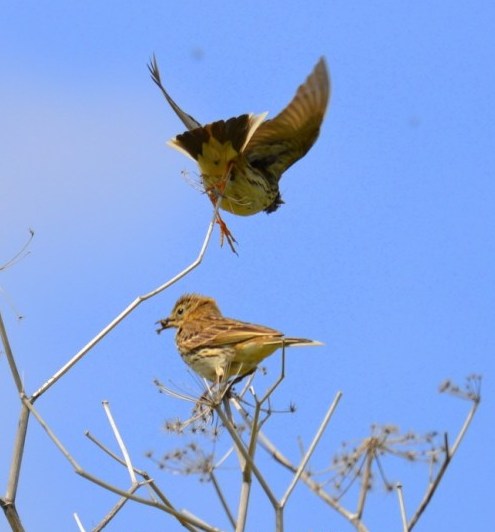
SUNDAY
JUNE 2 - 2013
BROOK
MEADOW
I went over to the
meadow this morning to take photos of the regular
conservation work session. There was a good crowd
there and the main task was cutting down the Hemlock
Water-dropwort which is threatening to spread again.
Really, it needs digging up like happened 2 years ago
on the Lumley area. I comtinue to enjoy my involvement
with the group, even though I am not able to do any
physical work. I also enjoy the coffee break served by
Pam Phillips.
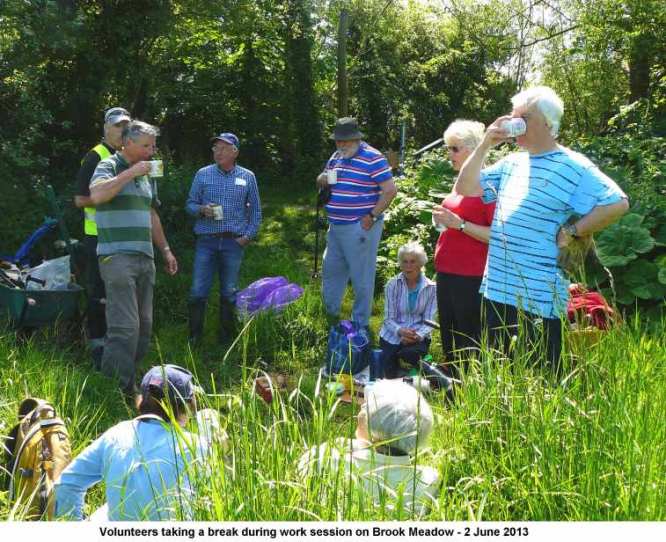
We found a few more
Ragged Robin flowers to take the total to 8,
which is not much to write home about! We also found
Azure and Large Red Damselflies on the
vegetation near the Lumley Stream.
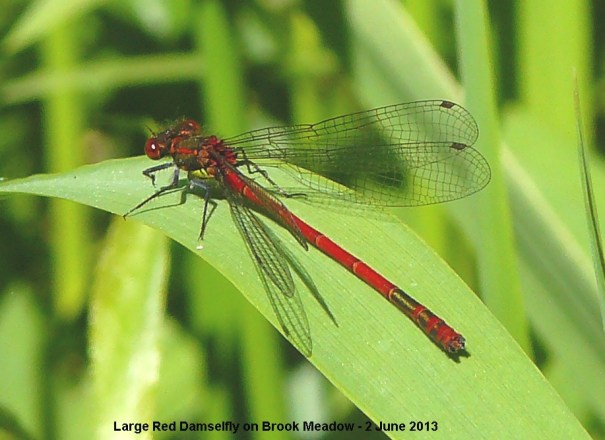
Copper
Underwing
The most interesting
find of the morning was by David Search who caught a
large moth in his hands. When he released it the moth
fluttered around on David's arms and coat before
flying off. I took a few photos as it fluttered
around, but none of them very good. However, the
moth's red underwings show up well, which suggests it
was a Copper Underwing (Amphipyra pyramidea). This
species has not been previously record on Brook
Meadow.
CORRECTION
- Poplar Hawkmoth
My moth expert Tony
Davis corrected me again on this identification. It is
several months too early for Copper Undering which is
a late summer / autumn species. The moth is a Poplar
Hawk-moth.

Ralph Hollins added
the following extra information about this moth. "From
what I know the moth you found had only emerged from
underground pupation within the last day or at most
two - once any Hawkmoth has spent a day or so
expanding its wings (hanging on a tree or wall) it is
very unlikely to be seen again except at a moth trap
so I think you can assume that your specimen came from
an egg laid on a tree leaf in Brook Meadow last June,
fed on the leaves from July to Sept, then pupated in a
cocoon just below the surface of the soil until this
May when it popped up to let you see it."
MILLPOND
NEWS
I checked the two Mute
Swan nests this morning and the birds were sitting as
usual with no sign of any hatching. Predicted date for
the Peter Pond nest is tomorrow! I did not hear the
Reed Warbler on Peter Pond today, though that could
have been due to David Gattrell clearing reeds from
the main channel leading into the pond.

OTHER
NEWS
Spotted
Flycatchers galore
Former Havant Wildlife
Group colleague, Ian Julian, who now lives in 'sunny
Bournemouth', wrote on Hoslist yesterday to say 'there
were probably thousands of Spotted Flycatchers along
the entire Dorset coastline, many in groups of 50 or
more, as far as Hengistbury Head and the Hampshire
border. Portland alone had 1,000.' Please come this
way, I have not seen one for years.
SATURDAY
JUNE 1 - 2013
BROOK
MEADOW
Red-headed
Cardinal Beetle - Pyrochroa
serraticornis
I spotted a bright red
beetle on a blade of grass behind the seat on Brook
Meadow. I took a few photos to look up when I got
home. A bit of research on the internet revealed its
identity as a Red-headed Cardinal Beetle (Pyrochroa
serraticornis), which is common on flowers and old
tree stumps. I have just two previous records of
Red-Headed Cardinal Beetle on Brook Meadow, both with
photos: 15-May-10 and 02-Jun-10.

Further
information
The Red-headed
Cardinal Beetle is a medium-sized beetle found in
woodland, along hedgerows and in parks and gardens.
The adults are present during the summer and can often
be found sunbathing on flowers or tree trunks. They
are predators and feed on other insects flying around
the flowers on which they are perched. The larvae are
flattened in appearance, which enables them to live
under loose bark where they feed on the larvae of
other insects or, if none are available, they may
devour each other!
The Red-headed
Cardinal Beetle is bright red, with black legs and
long, black, toothed antennae. There are two other
species of Cardinal Beetle in Britain, both of which
can be distinguished by their black heads. The
Black-headed Cardinal Beetle (Pyrochroa coccinea) is
rare, but found in similar habitats to the Red-headed
Cardinal Beetle; while the Scarce Cardinal Beetle is
only found at a few sites in Scotland and Wales, where
it lives in Birch woodland.
This information is
from . . . http://www.wildlifetrusts.org/species/red-headed-cardinal-beetle
See also Chinery's
Guide to Insects p.270
Ladybirds
As I was walking up
the main river path I came across two Ladybirds of
very contrasting sizes close to each other on the
Brambles. The large one was clearly a Harlequin
Ladybird and was in the process of consuming a
greenfly.
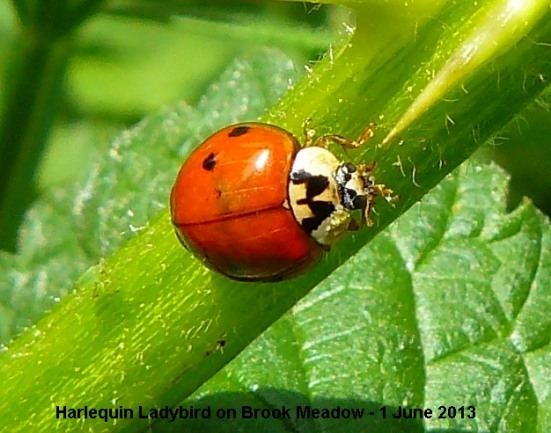
The small one was a
2-spot Ladybird, only half the size of the Harlequin
and no doubt could be its next meal.
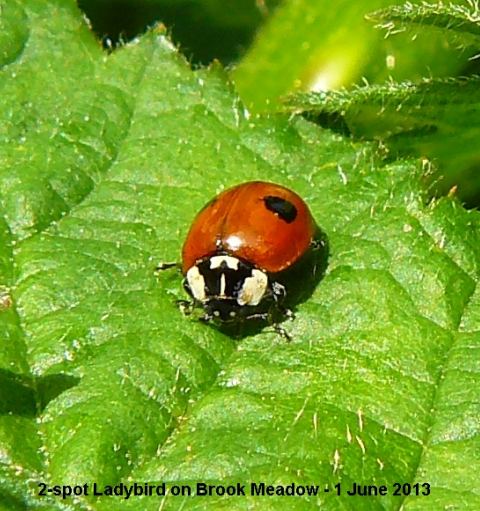
First
Ragged Robin
I have been checking
the Lumley area on a daily basis for the first flowers
of Ragged Robin. I saw my first ones this afternoon,
just 3 plants in flower on the southern section of the
Lumley area. They were about 4 weeks later than usual.
I am quite relieved to see any at all since last
year's count was the lowest since counts began in Year
2002.
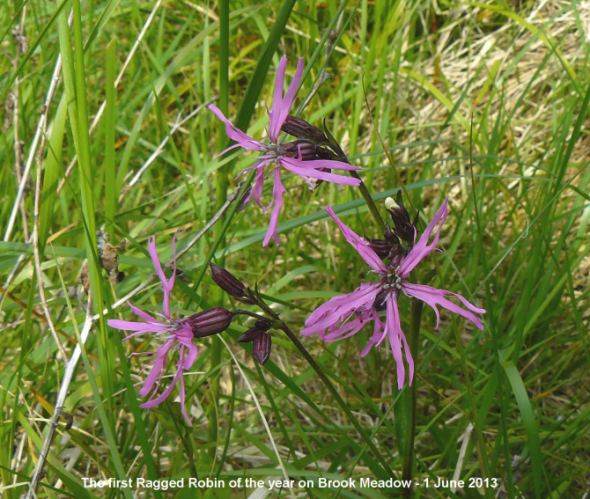
Stream
Water-crowfoot
There is a fine
display of Stream Water-crowfoot in the River Ems. It
has long trailing tresses of submerged leaves and
flowers with yellow honey guides on the inside of
white petals.
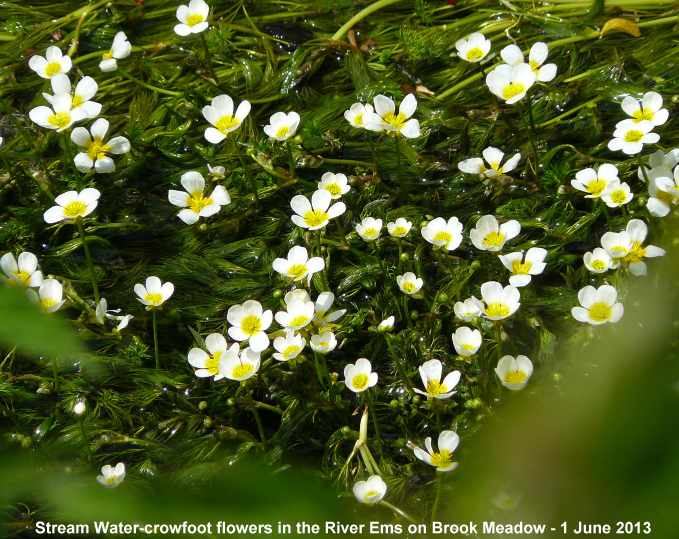
MILLPOND
NEWS
The three Great
Black-backed Gull chicks were clearly visible on
the centre raft on Slipper Millpond along with one of
the parents. The Mute Swan was snug on her nest
on the Peter Pond island; by my reckoning she has only
another a couple of days to wait before the 8 eggs
hatch and what a sight that could be! Meanwhile, the
5 Coot chicks on Peter Pond are growing fast
and look healthy. But the Coot chicks from the two
nests on the Slipper Millpond rafts have all gone -
down the throats of the gulls no doubt.
I was pleased to hear
a Reed Warbler singing from the northern
reedbeds on Peter Pond for first time this year. This
could be the same bird that I heard singing from the
reeds in the south west corner on May 27.
The Lesser
Sea-spurrey on the brickwork near the wooden
kissing gate at the north end of the western path
around Slipper Millpond is just in bud.
Marina
swans produce 8 cygnets
I had a phone call
from Gavin Miller at about 3pm this afternoon to say
there was a Mute Swan family in the marina area
outside his house with an astonishing 8 cygnets. This
must have been from a nest on the embankment of the
marina where swans regularly nest, though I must admit
I had not checked them this year and was unaware of
their nesting. I got on my bike to have a look and
there they were in the small bay below Slipper Mill.
Clearly, the cygnets will be vulnerable to predation
from the Great Black-backed Gulls which now have three
growing chicks on Slipper Millpond themselves to feed.
But we shall see.
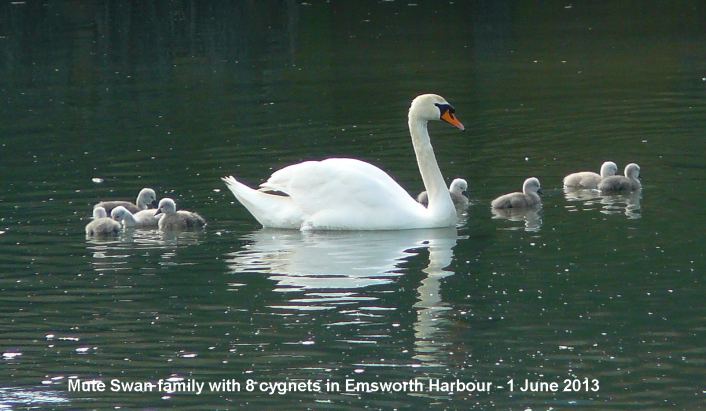
SATURDAY
June 1, 2013 - KINGLEY VALE
Heather Mills reports
on this morning's walk by the Havant Wildlife Group
with a cracking photo of Grizzled Skipper.
Go to . . . Havant
Wildlife Group
and take the link for 2013 reports
JOHN'S
BUTTERFLIES
Duke
of Burgundy
John Bogle recently
visited Noar Hill and the Rake Bottom area of Butser
Hill and was pleased to see that the Duke of Burgundy
have fared pretty well despite the terrible weather
last year with plenty seen at both sites. He says,
"I'd say numbers at Noar Hill are typical of the past
few years with around 20 seen together with half a
dozen Dingy Skippers and a single Grizzled Skipper.
Here
is John's fine image of both Duke of Burgundy and
Dingy Skipper
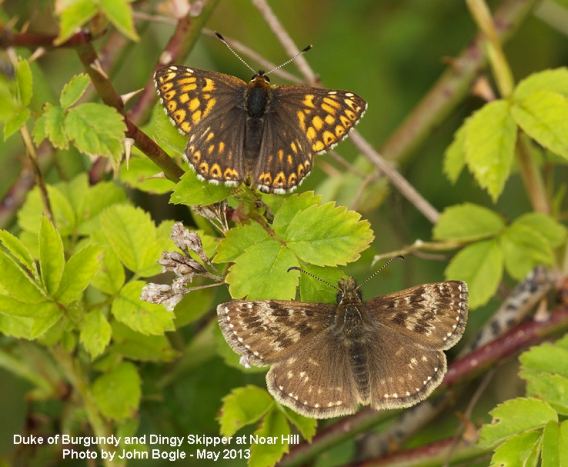
John says, "It's the
first time I've visited Rake Bottom and wish I'd gone
when I first heard about it several years ago. It's a
fair hike but well worth it with also around 20 Duke
of Burgundy found spread over several areas (probably
a lot more if I'd fully explored the place). Also
maybe a dozen Dingy Skippers and the same number of
Grizzled. A Green Hairstreak was at rake bottom
too. Unlike Noar Hill which is often quite busy this
site was relatively quiet - probably because of the
steep climbs!"
Here
is John's Hairstreak
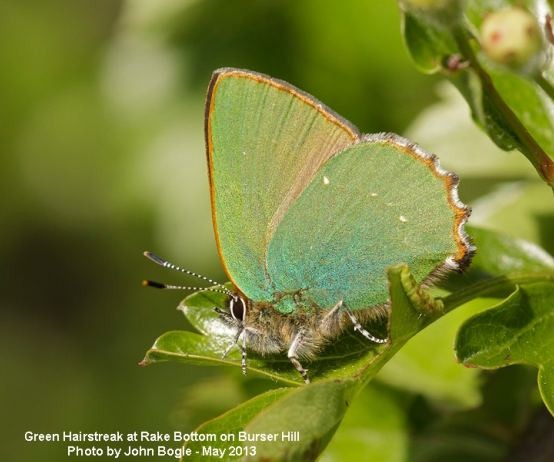
Small
Blue
Another trip took John
to Paulsgrove chalk pit which he says is a little gold
mine for Small Blue butterflies. He's lucky to have
this small colony is just a couple of minutes from
home. There are around 8-10 seen pretty much on par
with last year. Note: John's photo of the underwing of
the Small Blue showing black spots on a silver wing
looks much the same as that of a Holly Blue. The
obvious difference is the size with Small Blue being
far smaller, but size is not obvious from a photo.
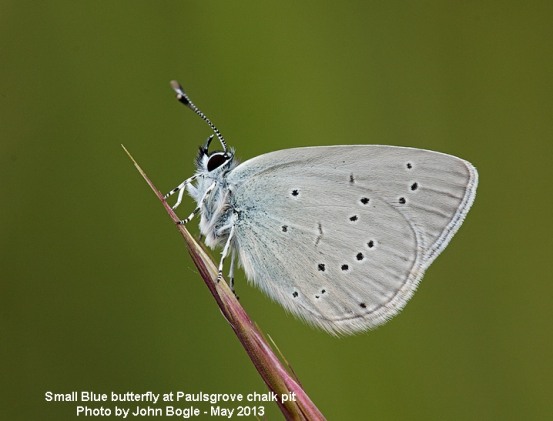
OTHER
NEWS
Correction
to Tony's dragonfly
John Bogle corrected
Tony Wootton's dragonfly photo from Somerset (May 24
entry). It is in fact a male Hairy Dragonfly. He says,
"When I was in Kent there were everywhere in my 'local
patch' in early spring - our earliest emerging
dragonfly I think. I've yet to see one in Hampshire
but I'm sure they are around here
somewhere!"
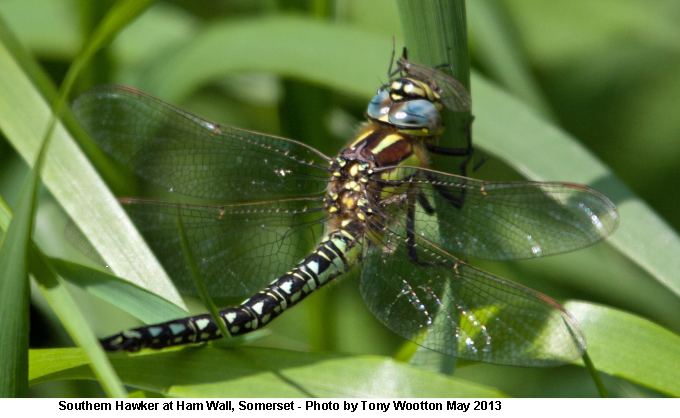
Reed
or Marsh Warbler?
There has been
considerable debate on Hoslist about the
identification of a small warbler singing from reeds
in Gosport. It was thought at first to be a rare Marsh
Warbler. Andy Johnson is convinced the slow-paced song
is Reed Warbler and not Marsh Warbler, which tends to
be much more fast and furious. For Andy the song is
conclusive, and outweighs any seemingly anomalous
plumage features. Richard Ford has done a nice video
with song of the bird, so you can listen and make your
own mind up. I would certainly put it down as a
standard Reed Warbler, but the debate continues.
Link to Richard's video on YouTube . . .
http://youtu.be/NmhQIk9l2dY
Langstone
Mill Pond
Peter Milinets-Raby
visited Langstone Mill Pond on an incoming tide this
afternoon.The highlights were as follows:
2 singing Reed
Warblers (heard only), 2 male Gadwall on the pond,
then flew off and seen to land on the ornamental lake
in the grounds of Wade Court. This is probably where
they are breeding. 3 pairs of Tufted Duck - no young,
so probably non-breeders, 2 Little Tern fishing as the
tide pushed in, 3 Common Tern, 1 Med Gull, 3
Bar-tailed Godwit, 1 Whimbrel, Mute Swan pair still
with 3 cygnets.
Little Egrets - At
least four nests can be viewed through the vegetation
(the rest are only partially visible) and all have
very small young in them - only a few days old. A pair
of Carrion Crows were loitering just a metre from
these nests waiting to catch a Little Egret off
guard!!!
For
earlier observations go to . . May
17-31